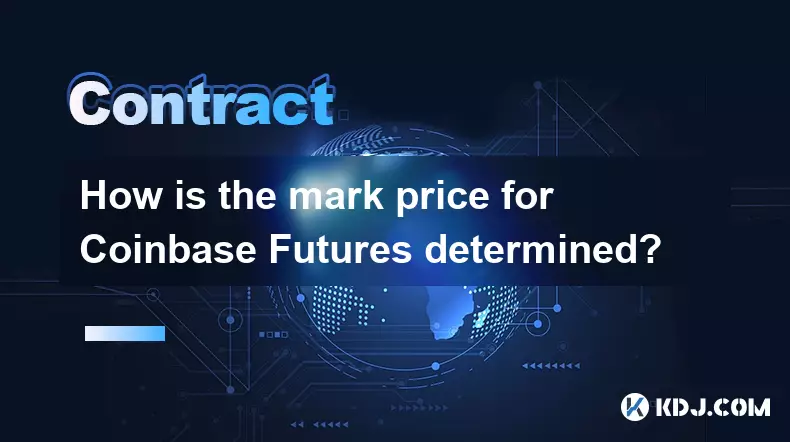-
 bitcoin
bitcoin $109667.069529 USD
-3.03% -
 ethereum
ethereum $3936.685804 USD
-4.07% -
 tether
tether $1.000493 USD
0.01% -
 xrp
xrp $2.771823 USD
-4.74% -
 bnb
bnb $957.805027 USD
-5.34% -
 solana
solana $196.735100 USD
-6.68% -
 usd-coin
usd-coin $0.999727 USD
-0.01% -
 dogecoin
dogecoin $0.227355 USD
-5.12% -
 tron
tron $0.335205 USD
-0.81% -
 cardano
cardano $0.779256 USD
-3.59% -
 ethena-usde
ethena-usde $0.999900 USD
-0.06% -
 hyperliquid
hyperliquid $42.492095 USD
-6.61% -
 chainlink
chainlink $20.501853 USD
-4.34% -
 avalanche
avalanche $28.952606 USD
-11.21% -
 stellar
stellar $0.356038 USD
-3.93%
How is the mark price for Coinbase Futures determined?
Coinbase Futures uses a mark price, combining index prices, spot data, and TWAP to prevent manipulation and ensure fair liquidations and funding rates.
Sep 17, 2025 at 08:55 pm

Understanding the Mark Price Mechanism in Coinbase Futures
1. The mark price on Coinbase Futures is designed to reflect the true market value of a futures contract and prevent manipulation during periods of high volatility. It is not simply the last traded price but rather a calculated value derived from external sources. This mechanism ensures that liquidations occur fairly and align with broader market conditions.
2. One primary component used in determining the mark price is the spot price of the underlying asset. Coinbase pulls this data from its own order book, which aggregates buy and sell orders for the cryptocurrency in question. The spot price acts as a baseline reference point, offering real-time insight into current demand and supply dynamics.
3. To further stabilize the mark price and reduce susceptibility to sudden spikes or flash crashes, Coinbase incorporates a time-weighted average price (TWAP) from its spot market. This means that instead of relying on a single momentary price, the system evaluates the average trading price over a defined interval, smoothing out anomalies and providing a more accurate valuation.
4. In addition to internal spot data, Coinbase may also reference prices from other reputable exchanges and third-party pricing aggregators. These external feeds help ensure that the mark price remains aligned with global market trends, especially when trading volume on Coinbase itself is low or imbalanced.
5. Funding rate calculations are closely tied to the mark price. The difference between the mark price and the index price influences how much traders pay or receive in funding payments. This linkage helps maintain equilibrium between perpetual contracts and the actual spot market by discouraging prolonged deviations in contract pricing.
Role of Index Pricing in Mark Price Calculation
1. An essential input for the mark price is the index price, which Coinbase constructs by aggregating spot prices from multiple trusted exchanges. This index serves as an objective benchmark unaffected by temporary imbalances on any single platform.
2. The selection of exchanges within the index follows strict criteria, including liquidity, trading volume, and security standards. Only platforms with consistent uptime and reliable APIs are included, ensuring the integrity of the data feeding into the index.
3. Each exchange’s contribution to the index is weighted based on its relative trading volume for the given asset pair. Higher-volume exchanges exert greater influence on the final index value, making it representative of where most trading activity occurs globally.
4. The index price is updated frequently—typically every few seconds—to capture rapid shifts in market sentiment. This dynamic updating allows the mark price to respond quickly to new information while still filtering out noise through averaging techniques.
5. By anchoring the mark price to an independently sourced index, Coinbase reduces the risk of price manipulation on its own order book affecting liquidation engines or funding rates. This separation enhances transparency and builds trust among institutional and retail participants alike.
Impact of Funding Rates on Price Alignment
1. Funding rates play a crucial role in maintaining parity between the futures contract price and the mark price. These periodic payments flow from long positions to short positions—or vice versa—depending on whether the contract trades above or below the mark price.
2. When the futures price exceeds the mark price, funding rates turn positive, meaning longs pay shorts. This incentivizes traders to open short positions or close longs, pushing the contract price back toward fair value.
3. Conversely, if the futures price falls below the mark price, funding becomes negative, transferring funds from shorts to longs. This encourages buying pressure that helps lift the contract price closer to the mark level.
4. The frequency of funding payments on Coinbase Futures is typically set at eight-hour intervals. This regular cadence ensures continuous adjustment without overwhelming traders with constant transactions.
5. The interplay between funding rates and the mark price creates a self-correcting mechanism that keeps futures contracts tightly coupled to real-world asset values, minimizing divergence even during turbulent market phases.
Common Questions About Coinbase Futures Pricing
What data sources does Coinbase use for its index price?Coinbase uses a basket of top-tier exchanges such as Kraken, Bitstamp, and Binance, selected based on liquidity and reliability. The exact composition may vary per asset but always includes major venues with deep order books and transparent operations.
Why doesn’t Coinbase use only its own spot price for the mark price?Relying solely on internal data could expose the system to manipulation, especially during low-liquidity events. Using external benchmarks ensures resilience and reflects broader market consensus beyond one exchange's ecosystem.
How often is the mark price updated?The mark price is recalculated continuously, usually every second, using the latest index readings and TWAP inputs. This enables precise tracking of market movements and supports accurate margin assessments.
Can traders access the raw data behind the mark price?While the full algorithm isn't publicly disclosed, Coinbase provides transparency through documentation detailing the methodology, data sources, and weighting mechanisms involved in constructing both the index and mark prices.
Disclaimer:info@kdj.com
The information provided is not trading advice. kdj.com does not assume any responsibility for any investments made based on the information provided in this article. Cryptocurrencies are highly volatile and it is highly recommended that you invest with caution after thorough research!
If you believe that the content used on this website infringes your copyright, please contact us immediately (info@kdj.com) and we will delete it promptly.
- Bitwise, Hyperliquid ETF, and Perp DEXs: A New Era in Crypto Trading?
- 2025-09-26 12:25:15
- Ozak AI Price Prediction: Analyst Bull Case for $5 by 2026?
- 2025-09-26 12:25:15
- Bitcoin Price Wobbles: Support Failure and Trader Sentiment in the Mix
- 2025-09-26 12:45:16
- Dogecoin, Memecoins, and the Bull Cycle: Are We Still Barking Up the Right Tree?
- 2025-09-26 12:45:16
- Plasma Ignites DeFi: A New Dawn for Stablecoins and TVL?
- 2025-09-26 12:50:01
- Crypto Tax, Senate Showdown, and Trump Relief: What's the Deal?
- 2025-09-26 12:30:01
Related knowledge

How do I enable the "scalping-only" mode for Cardano (ADA) contracts?
Sep 24,2025 at 03:19am
Understanding Scalping Strategies in Crypto Derivatives1. Scalping in cryptocurrency trading refers to executing multiple short-term trades within min...

What is the maximum position limit for Cardano (ADA) contracts?
Sep 23,2025 at 11:00pm
Understanding ADA Futures and Derivatives Market Structure1. Cardano (ADA) futures contracts are offered by several major cryptocurrency derivatives e...

What is the maker fee for Cardano (ADA) contracts?
Sep 26,2025 at 09:01am
Understanding Maker Fees in Cardano (ADA) Contracts1. The concept of maker fees applies broadly across decentralized exchanges and smart contract plat...

How can I view open interest in Cardano (ADA) contracts?
Sep 24,2025 at 07:36am
Understanding Open Interest in Cardano Derivatives1. Open interest refers to the total number of outstanding derivative contracts, such as futures or ...

What is the function of the insurance fund in Cardano (ADA) contracts?
Sep 24,2025 at 02:18am
Understanding the Role of Insurance Funds in Cardano Smart Contracts1. The insurance fund within Cardano's ecosystem is not a native feature directly ...

How can I view historical transaction records for Cardano (ADA) contracts?
Sep 24,2025 at 04:01pm
Understanding Cardano's On-Chain Data Structure1. Cardano operates on a proof-of-stake blockchain that records all transactions in blocks secured thro...

How do I enable the "scalping-only" mode for Cardano (ADA) contracts?
Sep 24,2025 at 03:19am
Understanding Scalping Strategies in Crypto Derivatives1. Scalping in cryptocurrency trading refers to executing multiple short-term trades within min...

What is the maximum position limit for Cardano (ADA) contracts?
Sep 23,2025 at 11:00pm
Understanding ADA Futures and Derivatives Market Structure1. Cardano (ADA) futures contracts are offered by several major cryptocurrency derivatives e...

What is the maker fee for Cardano (ADA) contracts?
Sep 26,2025 at 09:01am
Understanding Maker Fees in Cardano (ADA) Contracts1. The concept of maker fees applies broadly across decentralized exchanges and smart contract plat...

How can I view open interest in Cardano (ADA) contracts?
Sep 24,2025 at 07:36am
Understanding Open Interest in Cardano Derivatives1. Open interest refers to the total number of outstanding derivative contracts, such as futures or ...

What is the function of the insurance fund in Cardano (ADA) contracts?
Sep 24,2025 at 02:18am
Understanding the Role of Insurance Funds in Cardano Smart Contracts1. The insurance fund within Cardano's ecosystem is not a native feature directly ...

How can I view historical transaction records for Cardano (ADA) contracts?
Sep 24,2025 at 04:01pm
Understanding Cardano's On-Chain Data Structure1. Cardano operates on a proof-of-stake blockchain that records all transactions in blocks secured thro...
See all articles










































































